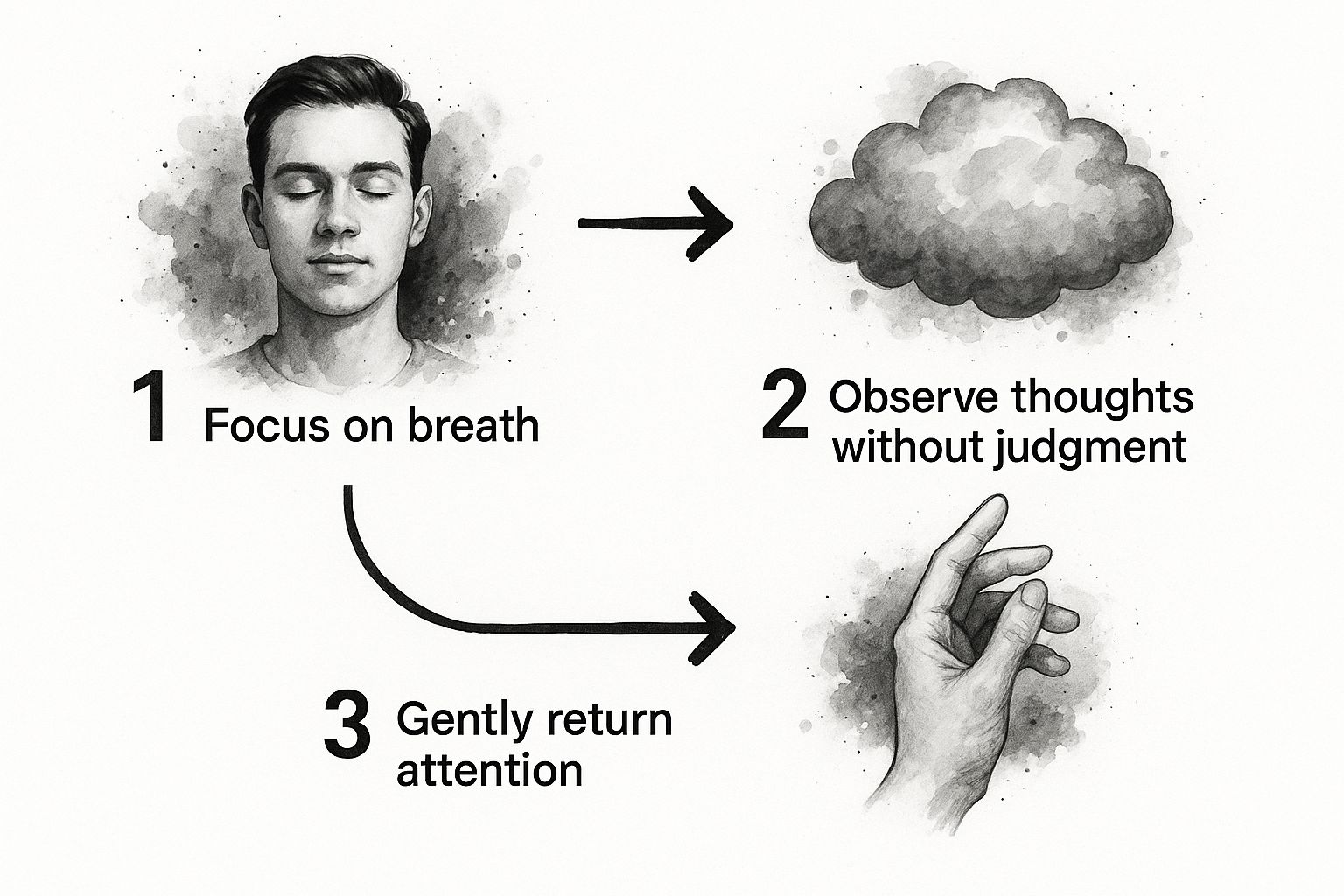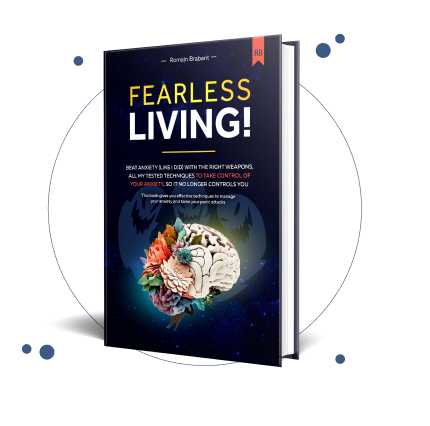
Learning how to control anxiety starts with one core belief: you can regain command over your mind and body. It’s not about fighting some invisible enemy, but rather a journey of learning, healing, and rediscovery. This involves a mix of practical, in-the-moment techniques and bigger lifestyle strategies designed to build resilience and genuine, lasting calm.
Your Path to a Panic-Free Life Starts Here

Feeling trapped by anxiety can be an unbelievably isolating experience. If you’re reading this, you probably know that feeling all too well—the racing heart, the thoughts that spiral out of control, the sense that you're losing your grip.
I want you to hear this loud and clear: genuine peace and lasting control are entirely within your reach. A life free from the constant fear of panic is not a distant dream; it is a destination you can reach.
This guide isn't about fighting a lifelong war against yourself. Forget that. Instead, it’s about learning a new way to relate to your mind and body. It's about shifting your relationship with anxiety from one of fear to one of understanding, and ultimately, to one of healing.
You Are Absolutely Not Alone
If you feel like you're the only one struggling this intensely, you couldn't be more wrong. Anxiety is the most common mental health issue on the planet, which means millions of people have walked this path and found their way to peace.
As of 2019, an estimated 301 million people worldwide were living with an anxiety disorder. And despite how common it is—and the fact that effective treatments exist—only about one in four people actually get the care they need. You can dig into these global mental health findings on the WHO website.
This guide is about making sure you have the tools to be in the group that finds relief and truly heals. It’s about moving from just surviving to actually thriving.
The goal isn't to get rid of anxiety entirely—it's a normal human emotion, after all. The real aim is to dial down its volume so it no longer runs your life. You’re learning to become the calm, confident pilot of your own mind, fully capable of navigating toward a panic-free life.
The Pillars of Lasting Calm
So, how do we build a life free from constant panic? We focus on three core areas. Think of these as the legs of a sturdy stool—each one is essential for creating a stable foundation for your well-being and long-term healing.
By methodically strengthening these pillars, you build a structure of resilience that can handle whatever life throws at you.
Here's a quick look at the foundational toolkit we'll build together throughout this guide.
Your Anxiety Control Toolkit
Here are the three foundational pillars for building a calmer, more resilient mind.
| Pillar | What It Means for You | A First Step You Can Take |
|---|---|---|
| Mindful Awareness | Learning to spot your unique anxiety triggers and thought patterns without judging them. | Notice one small physical sensation right now (like tight shoulders) without trying to fix it. Just observe. |
| Practical Coping Skills | Having immediate, in-the-moment techniques ready to ground yourself when anxiety spikes. | Try a simple box breath: Inhale for a count of 4, hold for 4, exhale for 4, and hold for 4. Repeat. |
| Resilient Lifestyle | Making small, consistent daily choices that support a calm nervous system over the long haul. | Swap one sugary drink for a glass of water today. It’s a small change that helps stabilize your mood. |
This framework isn't some magical cure. It’s a clear, actionable path forward—a steady, empowering process of reclaiming your peace, one step at a time. This is how healing happens.
Learning to Listen to Your Anxious Mind

What if we stopped treating anxiety like a monster to be slain? Instead, let's try a different, more hopeful approach.
Think of it as a smoke detector that’s a little too sensitive. It means well—it’s trying to protect you—but its wiring is a bit off. Learning how to control anxiety really starts when you become a curious detective of your own mind and body, not its enemy. This curiosity is the beginning of healing.
This means shifting your entire perspective from fear to curiosity. Instead of bracing for impact whenever that familiar feeling rises, you learn to lean in and gently ask, "What is this really trying to tell me?" This simple shift is the first—and most powerful—step toward dismantling anxiety at its roots.
This process is deeply personal. Research shows that anxiety manifests differently across populations; for instance, women are 1.6 times more likely than men to experience anxiety disorders. This just highlights how unique the journey is, which is why understanding your specific patterns is so crucial. You can discover more insights about these anxiety statistics to see just how widely these experiences can vary.
Uncovering Your Subtle Triggers
Most of us can point to our obvious triggers—public speaking, a tough conversation, a looming deadline. But the real progress toward a panic-free life happens when you start noticing the subtle cues that set the stage for anxiety long before the main event.
These could be internal thought patterns or physical sensations you’ve been brushing off for years.
- Catastrophic Thinking: Do you find yourself immediately jumping to the worst-case scenario after a minor setback? This habit is a powerful anxiety accelerant.
- Physical Tension: Pay attention to where you hold stress. Is it a clenched jaw? Tense shoulders? That familiar knot in your stomach? These are early warning signs from your nervous system.
- Energy Levels: A sudden dip in energy or feeling "wired but tired" can often come right before a spike in anxious feelings.
By learning to spot these precursors, you gain a massive advantage. You're no longer ambushed by a panic attack; you see the early smoke signals and have time to respond with calm, deliberate action. This is a skill, and it brings immense hope.
From Panic to Preparation
One of the most powerful shifts on the path to healing is to re-label the body's natural responses. Imagine you have a big presentation coming up. Your heart starts beating faster, and your palms get a little sweaty.
The anxious mind immediately screams, "Oh no, I'm having a panic attack!"
But what if you reframed that? What if, instead, you told yourself, "This is just my body gearing up. It's giving me the energy and focus I need to nail this." This isn't just wishful thinking; it’s about accurately interpreting your body’s signals. A racing heart before a challenge isn't panic—it's preparation.
This reframing technique alone can short-circuit the fear-of-fear cycle that traps so many people. You stop fighting your body and start working with it. And that changes everything.
Grounding Techniques for In-the-Moment Relief
When your heart pounds and your thoughts are racing, you don’t have time for complicated theories. You need an emergency toolkit—practical, reliable actions that work right now to pull you back from the edge. This is all about reclaiming control when your body feels like it’s been hijacked by panic.
The real hope here is profound: you can learn to interrupt the panic cycle before it takes hold. Think of these techniques as circuit breakers. They’re designed to restore a sense of command over your body and mind when you need it most. It's not magic; it’s a skill. And like any skill, it gets stronger every time you practice, paving the way for a calmer future.
The 5-4-3-2-1 Sensory Method
One of the best ways to stop spiraling thoughts is to pull your focus out of your head and into the world around you. The 5-4-3-2-1 method uses your senses to anchor you firmly in the present, making it nearly impossible for your mind to keep cycling through worries about yesterday or tomorrow.
The beauty of this is its simplicity. You can do it anywhere, anytime, without anyone even knowing.
- 5 Things You Can See: Look around and name five distinct objects. Don't just glance; really notice the details. "I see my blue coffee mug, a hairline crack in the ceiling, the green spine of that book, a dust particle floating in a sunbeam, and my black keyboard."
- 4 Things You Can Touch: Acknowledge four different physical sensations. "I can feel the smooth, cool surface of my desk, the soft fabric of my sweater against my arm, the slight draft from the window, and my feet pressed firmly on the floor."
- 3 Things You Can Hear: Listen carefully for three sounds you might normally tune out. "I hear the low hum of the computer, a distant siren, and the sound of my own quiet breathing."
- 2 Things You Can Smell: Identify two distinct scents. If you can’t immediately find any, you can imagine two of your favorites, like fresh coffee brewing or the smell of rain on hot pavement.
- 1 Thing You Can Taste: Focus on one specific taste. This could be the faint minty-ness from your morning toothpaste, or you can just take a sip of water and notice its flavor.
This isn't just a distraction. It's a powerful cognitive shift. You're actively redirecting your brain's resources away from the amygdala (the fear center) and toward the prefrontal cortex (the thinking, rational center).
Box Breathing for Discreet Calm
Sometimes you need a tool you can use without anyone noticing—maybe during a stressful meeting or on a crowded train. Box breathing, also known as four-square breathing, is perfect for this. It directly regulates your autonomic nervous system, sending a clear signal to your body that it’s safe to relax.
For a deeper dive, our complete guide to breathing exercises for anxiety offers more advanced techniques you can explore.
Here’s the simple pattern:
- Inhale slowly through your nose for a count of four.
- Gently hold your breath for a count of four.
- Exhale slowly through your mouth for a count of four.
- Hold at the bottom of the exhale for another count of four.
- Repeat this cycle for at least a minute or two.
This rhythmic breathing is incredibly effective at lowering your heart rate and blood pressure, calming the physical storm of anxiety. This infographic helps visualize the core principle: calming your mind through focused attention.

As the visual shows, mindfulness is a simple loop of focusing your attention, noticing when it wanders, and gently redirecting it back. It’s a skill you strengthen with every single repetition.
By practicing these grounding techniques when you're calm, you build the muscle memory needed to access them instantly when panic strikes. This is how you create a life where you are in control, not your anxiety. This is how you heal.
How to Rewire Your Anxious Thought Patterns
Grounding techniques are a lifeline when panic hits, but what about stopping the alarm from going off in the first place? That's where the real, lasting change happens. It involves methodically taking apart the very thought patterns that fuel your fear, and this is entirely achievable.
Anxiety is a master storyteller. It spins dramatic, terrifying tales that almost always start with "what if" and end with the worst possible outcome. Your job isn't to wrestle with these stories. It's to become a compassionate editor, gently pointing out the plot holes and rewriting the ending. This skill is your key to long-term healing.
This isn't about slapping a layer of fake positivity on top of fear. It’s about building a more balanced, realistic inner voice. Every time you do this, you loosen anxiety's grip. This process, known as cognitive restructuring, is one of the most powerful tools for long-term anxiety relief.
Research backs this up time and time again: by changing your thoughts, you can actually change your brain's chemistry and how you react emotionally. You're building a new mental habit—one that defaults to calm instead of code red, making a panic-free life your new normal.
Questioning Your Anxious Story
The next time a wave of anxiety rolls in, see it for what it is: a story your brain is telling you. Let's walk through a classic example. You get a vague email from your boss: "We need to talk tomorrow morning."
Instantly, the anxious story starts playing on a loop: "I'm getting fired. I must have screwed something up. My career is over." This narrative feels completely real, triggering a physical stress response—pounding heart, tight chest, the works.
Instead of just accepting this story as fact, start asking some gentle, curious questions. Think of yourself as a kind detective, simply gathering the facts.
- "What's the actual evidence for this story?" Have you received any negative feedback lately? Is there any real data pointing to this conclusion, or is it purely a feeling?
- "What's a more likely, or at least an alternative, outcome?" Maybe your boss wants to put you on a new project, praise something you did well, or just ask for your opinion. There are dozens of neutral or even positive possibilities.
- "How would I advise a friend in this exact spot?" You'd almost certainly tell a friend not to jump to the worst-case scenario and to just wait for more information. Give yourself that same logical, compassionate advice.
By practicing this kind of questioning, you aren't trying to ignore the fear. You're actively engaging with it from a position of strength and reason, which systematically drains its power. You’re teaching your brain that the first alarm is often a false one. This is a profound step toward healing.
From Anxious Thoughts to Balanced Truths
The final move is to craft a new, more balanced thought. This is your rewritten story.
- Anxious Thought: "I'm definitely getting fired."
- Balanced Truth: "I don't actually know what this meeting is about, and assuming the worst isn't helping me. It's just as likely it's about a current project. I'll deal with it when it happens tomorrow."
This reframing is a skill. It will feel awkward and unnatural at first, but with practice, it becomes your new default setting. Each time you challenge an anxious thought and replace it with a more grounded one, you are literally rewiring the neural pathways in your brain. This is the foundation of a life where you control your thoughts, not the other way around.
Building a Lifestyle That Resists Anxiety

True, lasting freedom from anxiety isn't something you achieve overnight. It’s built, piece by piece, through the small, consistent habits you practice every single day. This is where real resilience is born and where healing truly takes root.
By making deliberate choices about how you live, you’re essentially constructing a foundation so strong that anxiety struggles to find a crack.
This isn’t about chasing perfection or following generic advice. We’re diving into practical, sustainable lifestyle shifts that genuinely fortify your mind and body against stress. It’s about proving to yourself that you hold the power to create a calmer, more controlled, and panic-free life.
Fueling Your Mind with Smart Nutrition
What you put on your plate has a direct line to how you feel, and this connection is incredibly powerful when it comes to anxiety. Think about it: unstable blood sugar from sugary snacks and refined carbs can send you on a rollercoaster of energy crashes and mood swings, which feel a lot like anxiety.
Imagine your mood is a bonfire. Processed, sugary foods are like throwing on a handful of dry leaves—you get a big, fast flare-up, but it burns out just as quickly, leaving you shaky and depleted.
On the other hand, complex carbs, lean proteins, and healthy fats are like solid logs. They burn slow and steady, keeping your mood and energy stable for hours.
Choosing a handful of almonds over a candy bar isn't just a "healthy" choice; it's a strategic move to keep your nervous system balanced. This is a real, tangible way you can how to control anxiety from the inside out. For a deeper dive, check out our guide on specific lifestyle and diet changes for anxiety management.
The message here is incredibly empowering: every meal and snack is an opportunity to actively choose calm over chaos. You are not a passive victim of your biochemistry; you are its architect. This is hope you can taste.
The Power of Restorative Sleep
Sleep is when your brain does its most critical emotional housekeeping. Skimping on quality sleep tanks your resilience to stress, leaving you wide open to anxious thoughts and the threat of panic. Prioritizing sleep is a non-negotiable step toward healing.
The trick is to create a "wind-down routine" that signals to your nervous system that it’s time to power down. An hour or so before bed, ditch the screens—that blue light messes with your melatonin production—and do something genuinely calming.
- Read a physical book (not on a tablet or phone).
- Listen to some mellow music or a relaxing podcast.
- Do a few gentle stretches or jot down your thoughts in a journal.
- Take a warm bath or shower.
This ritual teaches your brain to associate your bedroom with rest, not with racing thoughts and worry. It's a key part of building a panic-free life.
Movement as a Mental Reset
When anxiety spikes, your body gets flooded with stress hormones like adrenaline and cortisol. One of the most effective ways to burn off these chemicals and restore balance is simply to move.
You don't need to run a marathon. Study after study shows that even moderate exercise, like a brisk 15-minute walk, can make a huge difference in anxiety symptoms. It shifts your focus, releases mood-lifting endorphins, and helps your body complete the stress cycle.
Think of it as hitting a reset button for your entire nervous system. By weaving these small habits into your daily life, you're actively building a life where anxiety has less and less power over you.
When to Partner with a Professional for Support
Deciding to reach out for professional help isn't a sign of weakness—it’s one of the most powerful and courageous steps you can take on your healing journey. Think of it as bringing in an expert guide to help you navigate a tricky, overgrown trail you've been trying to clear on your own.
While self-help strategies are incredibly effective, there are times when partnering with a professional can accelerate your progress toward a panic-free life. This isn't a last resort; it's a proactive, hopeful move toward taking your life back for good.
Recognizing the Signs
So, how do you know when it’s time to call in some backup? The signs are usually pretty clear if you know what to look for. If anxiety is consistently getting in the way of your daily life, that's a huge signal that extra support could be transformative.
Consider reaching out if you notice:
- Persistent Disruption: Anxiety is regularly derailing your performance at work, putting a strain on your relationships, or keeping you from hobbies you used to love.
- Overwhelming Feelings: The physical symptoms or constant worry just feel too big to handle alone, no matter which self-help tools you've tried.
- Limited Progress: You feel like you've hit a wall. You've made some strides, but you just can't seem to get over a particular hurdle on your own.
Seeking support is an act of profound strength. It means you are taking your healing seriously and are ready to use every tool available to build a life free from panic. Hope and help are available.
There are different types of professionals who can help, like therapists, psychologists, and psychiatrists. Many use proven approaches like Cognitive Behavioral Therapy (CBT), which is fantastic for zeroing in on the thought patterns and behaviors that keep anxiety going.
To find the right fit, it helps to understand what makes each professional different. You can dive deeper into the options in our article on psychotherapy for anxiety. Learning how to control anxiety is a journey, and a good therapist can be an invaluable partner along the way.
Your Questions About Controlling Anxiety, Answered
As you start figuring this all out, it's totally normal to have questions. Everyone’s path to learning how to control anxiety looks a little different, but the goal is the same: a calmer, more peaceful life. And trust me, it's achievable.
Let's dive into some of the most common concerns I hear and tackle them with honest, realistic answers that are full of hope.
How Long Does It Take to See a Change?
This is the big one, isn't it? The truth is, healing from anxiety is a gradual process. It’s all about progress, not perfection. While some grounding techniques can give you immediate relief in a really tough moment, the lasting change—the deep healing—comes from using these new skills consistently.
Think of it less like an overnight cure and more like building momentum. Every small step you take, every time you choose a new response, you're moving forward toward a life with less panic and more peace.
Can Anxiety Be Completely Cured?
I think a better way to look at this is through the lens of management and mastery. Anxiety is a natural, hardwired human emotion—part of our survival toolkit. The goal isn't to surgically remove it from your brain. Instead, you can absolutely learn to turn down its volume.
The aim is to reduce its intensity and how often it shows up, to the point where it no longer runs your life. Many people reach a state where panic attacks become a distant memory.
You're building the skills to live peacefully alongside it, so you can finally hear your own calm, confident voice again. That’s what being in control really feels like, and that is a truly hopeful and achievable goal.
What if I Have a Setback?
First, let's get one thing straight: setbacks are a normal, expected part of healing. They are not a sign of failure. I can't stress that enough. They do not mean you won't get better.
Think of them as pop quizzes. They're opportunities to dust off your tools, practice what you've learned, and—most importantly—show yourself some of the compassion you've been working on.
Every single time you navigate a difficult day, you're building resilience. You're proving to yourself that you can handle it, which makes you that much stronger for whatever comes next on your path to a panic-free life.
Ready to turn these ideas into real-world practice? The Anxiety Checklist is a complete system designed to guide you. It's packed with practical tools, including a 93-point interactive checklist and worksheets, to help you build your toolkit for fearless living. Start reclaiming your peace today at https://anxietychecklist.com.

